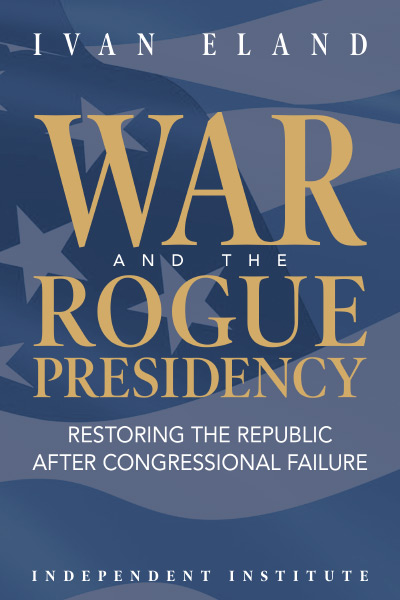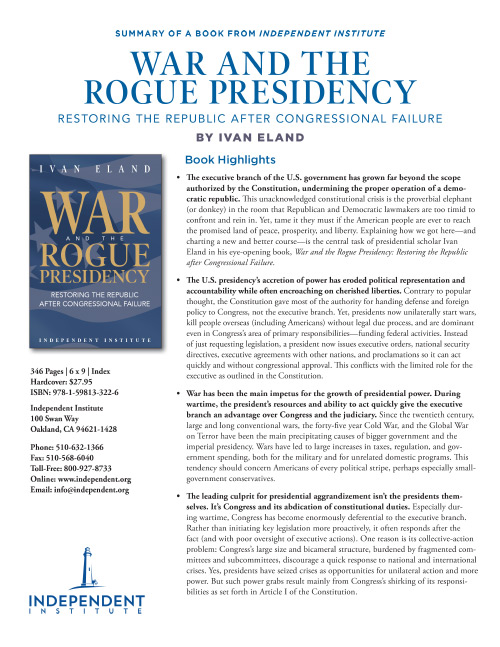Highlights
- The executive branch of the U.S. government has grown far beyond the scope authorized by the Constitution, undermining the proper operation of a democratic republic. This unacknowledged constitutional crisis is the proverbial elephant (or donkey) in the room that Republican and Democratic lawmakers are too timid to confront and rein in. Yet, tame it they must if the American people are ever to reach the promised land of peace, prosperity, and liberty. Explaining how we got here—and charting a new and better course—is the central task of presidential scholar Ivan Eland in his eye-opening book, War and the Rogue Presidency: Restoring the Republic after Congressional Failure.
- The U.S. presidency’s accretion of power has eroded political representation and accountability while often encroaching on cherished liberties. Contrary to popular thought, the Constitution gave most of the authority for handing defense and foreign policy to Congress, not the executive branch. Yet, presidents now unilaterally start wars, kill people overseas (including Americans) without legal due process, and are dominant even in Congress’s area of primary responsibilities—funding federal activities. Instead of just requesting legislation, a president now issues executive orders, national security directives, executive agreements with other nations, and proclamations so it can act quickly and without congressional approval. This conflicts with the limited role for the executive as outlined in the Constitution.
- War has been the main impetus for the growth of presidential power. During wartime, the president’s resources and ability to act quickly give the executive branch an advantage over Congress and the judiciary. Since the twentieth century, large and long conventional wars, the forty-five year Cold War, and the Global War on Terror have been the main precipitating causes of bigger government and the imperial presidency. Wars have led to large increases in taxes, regulation, and government spending, both for the military and for unrelated domestic programs. This tendency should concern Americans of every political stripe, perhaps especially small-government conservatives.
- The leading culprit for presidential aggrandizement isn’t the presidents themselves. It’s Congress and its abdication of constitutional duties. Especially during wartime, Congress has become enormously deferential to the executive branch. Rather than initiating key legislation more proactively, it often responds after the fact (and with poor oversight of executive actions). One reason is its collective-action problem: Congress’s large size and bicameral structure, burdened by fragmented committees and subcommittees, discourage a quick response to national and international crises. Yes, presidents have seized crises as opportunities for unilateral action and more power. But such power grabs result mainly from Congress’s shirking of its responsibilities as set forth in Article I of the Constitution.
- At a time when partisan acrimony has reached new heights, War and the Rogue Presidency offers value for readers across the political divide. Conservatives who lament the erosion of republican and federalist traditions will learn how America’s response to military conflicts has centralized and aggrandized federal power. Progressives worried about social disparities will see how the untying of the executive branch from its constitutional moorings has undermined political responsiveness, favoring the elite classes at the expense of disenfranchised groups. Libertarians who champion private-property rights and civil liberties will better understand why new thinking about the structure of government is crucial for the flourishing of a free society. Most of all, readers will come away understanding how the presidency lost its constitutional bearings—and how Congress can become the proper check on executive power as the framers of the Constitution intended.
Synopsis
The Office of the President of the United States of America isn’t what it used to be—it’s morphed into an overgrown beast. Originally envisioned as a branch of government that would mostly just carry out the will of Congress, it is now in many ways the dominant player, presiding over a bureaucracy with vastly more resources and powers than were authorized by the Constitution. Ironically, the main cause of this transformation is Congress itself.
In War and the Rogue Presidency: Restoring the Republic after Congressional Failure, presidential scholar Ivan Eland (Eleven Presidents, Recarving Rushmore, The Empire Has No Clothes) traces the trajectories of the executive branch and Congress, from the Constitutional Convention to the Obama and Trump years, cataloguing the de facto transfer of power from “the people’s branch” to an increasingly emboldened “rogue” presidency. The result is a landmark study that answers the lingering mystery of U.S. history: How, in a nation whose founders championed a limited government constrained by checks and balances, did the presidency acquire powers not enumerated in the Constitution?
Congress’s perennial in-fighting often inhibits passage of promising legislation and effective oversight of the executive branch. Moreover, Eland shows, the legislature is especially prone to shirking its constitutional responsibilities during wartime, when Congress is all too willing to let presidents set the agenda, often even on domestic issues and at the expense of constitutional protocol. As a result of this inaction and cowardice, wars have become major inflection points in the growth of executive power at home and abroad, enabling presidents to reach into realms once viewed as constitutionally off-limits. The consequence for the American people has been a growing sense of frustration with a federal bureaucracy less responsive to their needs, rather than confidence in a responsive government closely directed by their elected representatives.
More than a history of executive branch transformation, War and the Rogue Presidency points out precisely how Congress has failed the people—thus enabling future lawmakers to avoid similar pitfalls. Offering numerous recommendations to put Congress back in the driver’s seat of the federal government, Eland’s analysis is an important contribution toward fulfilling the Founders’ mission of creating “a more perfect union.”
Imperial Presidency, Rogue Presidency
To explain the rogue presidency—and its causes, consequences, and cures—Eland notes that we must first understand its profound reach. Today, the executive branch of the U.S. government is a sprawling bureaucracy that accounts for 99 percent of federal employees and spends the equivalent of about 17 percent of the country’s gross domestic product. More importantly, it commands far more power than the Constitution’s framers enumerated in the nation’s federal charter. But when and how did the executive branch’s transformation begin?
Although the growth spurt in the executive branch accelerated during the twentieth century, U.S. foreign policy from its onset was plagued with “creeping despotism.” Beginning with George Washington, presidents have acted as if they possessed the extra-constitutional “inherent power” championed by Alexander Hamilton. Washington’s Neutrality Proclamation, for example, usurped Congress’s constitutional prerogative on the question of whether the United States would get involved in England’s war with France. Similarly, Thomas Jefferson’s Barbary War, James Polk’s provocation of war with Mexico, and Franklin Pierce’s coerced opening of trade with Japan also usurped Congress’s responsibility for setting defense and foreign policy. New assertions of presidential power, however, were often met with congressional pushback, including immediately after the two world wars.
Not until Truman and the Korean War did the presidents take their country into massive wars without congressional approval. Modern presidents also claim “executive privilege” to initiate covert operations unsanctioned by Congress, top-level agreements with foreign nations, and executive orders with no enabling legislation. This status quo is taken for granted. Most popular coverage of the Oval Office accepts the broad powers of the presidency as “the natural order of things,” even though they run counter to the president’s authority as spelled out in Article II, Sections 2 & 3 of the Constitution.
War Is the Health of the State
Muckraking journalist Randolph Bourne famously quipped a century ago that “war is the health of the state”—meaning that governments gain tremendous power at the expense of civil society during wartime. War causes government to grow even at home, and war is especially a tonic for the growth of the executive branch.
Eland traces the history of federal domestic programs launched during wartime. The list is staggering, beginning with taxes. The income tax, progressive taxation, double taxation, tax withholding, tax expenditures (a.k.a. tax loopholes), the estate tax, gas taxes, and the IRS all have their origins in wartime. Social programs originating during wartime include relief for the poor and public works, Social Security, expansion of Medicaid to cover preventive care for children, public housing and rent control, federal involvement in daycare, grants-in-aid to states, and even federal involvement in regulating marriage.
Federal domestic efforts begun during wartime to address the economy more broadly include measures to combat unemployment, price controls, healthcare market interventions, nationalization of industries, involvement in labor relations, inflationary money printing, financial bailouts, regulation of food and alcohol, “wars” on prostitution, and even daylight saving time.
Reclaiming Congressional Authority
The expansion of executive power—especially since the dawn of the Cold War—is due less to presidential power grabs than to Congress’s dereliction of duties. The presidency isn’t inherently imperial, it’s contingently imperial. How might Congress regain its role as spelled out in the Constitution? Eland offers numerous recommendations.
Congress as currently structured has numerous flaws that create perverse incentives or otherwise impede its ability to act. Some of these flaws could be fixed by Congress itself. The committee structure, for example, decentralizes power to such a degree that important bills can wither on the vine. Centralizing congressional power, eliminating the seniority system, ending the “horse trading” that accompanies the congressional budget process, and making it harder for legislators to add special-interest riders to legislation—all would give congressional leaders greater control of their chambers, better enabling Congress to counter the aggrandizement of executive power. Congress should also more aggressively seek information held by the executive branch.
Congress, Eland argues, should repeal the confusing War Powers Resolution and strictly enforce the Constitution and the Authorization for Use of Military Force that presidents have abused in their prosecution of the War on Terror, including by conducting warrantless spying on Americans. More broadly, Congress should establish a statutory charter for the intelligence community, outlaw the covert destabilization of other governments during peacetime, and require that funding for intelligence agencies be made public. Eland offers several additional recommendations for Congress, as well as changes for the federal judiciary and structural changes in the executive branch itself.
With these and related changes, Congress could better deter presidential usurpations and abuses of power. And with congressional power properly restored, citizens could hope for a legislature more responsive to their needs.
“James Madison’s system of checks and balances, enshrined in the Constitution, can be revitalized if the aforementioned measures are taken to restore Congress’s standing and if the federal courts abandon their fear of pushback on executive aggrandizement in the national security and foreign policy arenas,” Eland writes.








